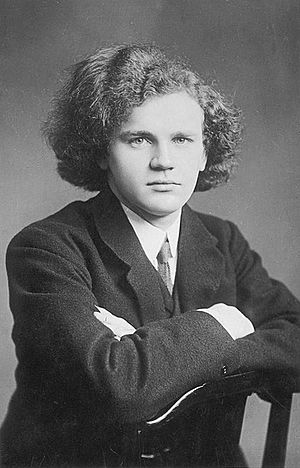Wilhelm Backhaus facts for kids
Wilhelm Backhaus was a famous German pianist and teacher. He was born on March 26, 1884, and passed away on July 5, 1969. People especially loved his performances of music by Mozart, Beethoven, Schumann, Chopin, and Brahms. He was also admired for playing chamber music, which is music for a small group of instruments.
Contents
Early Life and Music Training
Wilhelm Backhaus was born in Leipzig, a city in Germany. His father was a well-known architect. Wilhelm started learning piano at age four from his mother, who played piano as a hobby.
His talent was quickly noticed by Arthur Nikisch, a famous conductor. Because of Nikisch's advice, Backhaus studied at the Leipzig Conservatory from 1891 to 1899. After that, he took private piano lessons with Eugen d'Albert in Frankfurt. When he was about nine or ten years old, he heard d'Albert play two piano concertos by Johannes Brahms. Brahms himself conducted these concerts.
Concerts and Teaching Around the World
Backhaus went on his first concert tour when he was sixteen. In 1900, he visited England. He played for the first time in Manchester in 1901. In 1902, he performed at the Hallé Concerts and later at the Queen's Hall in London. He played six different piano concertos at the Promenade Concerts.
In 1904, he became a piano professor at the Royal Manchester College of Music. In 1905, he won the Anton Rubinstein Competition. The famous composer Béla Bartók came in second place. Backhaus traveled a lot during his life. In 1921, he gave seventeen concerts in Buenos Aires in less than three weeks.
He first played in the United States on January 5, 1912. He was the main performer in Beethoven's 5th Piano Concerto, known as the "Emperor" concerto. He played with Walter Damrosch and the New York Symphony Orchestra. In 1926, he taught at the Curtis Institute of Music. In 1930, he moved to Lugano and became a citizen of Switzerland.
Wilhelm Backhaus died in Villach, Austria, where he was supposed to play a concert. His last performance a few days earlier in Ossiach was recorded.
His Time During Nazi Germany
After the Nazis took power in Germany, Backhaus met Adolf Hitler in May 1933. He even flew with Hitler to Munich. That same year, he became an advisor for a Nazi group called Kameradschaft der deutschen Künstler (Fellowship of German Artists).
For the elections on March 29, 1936, Backhaus wrote a statement in a magazine. He said that "Nobody loves German art, and especially German music, as much as Adolf Hitler." A month later, on Hitler's 47th birthday, Hitler made Backhaus a professor. He also invited him to the annual Nazi party meeting in Nuremberg that September.
In November 1938, a violinist named Leila Doubleday Pirani went to a Backhaus concert in London. She was with another Jewish violinist, Alma Rosé. Rosé told Pirani that Backhaus was a "great friend of the family." After the concert, Rosé took Pirani backstage to say hello to Backhaus. Pirani wrote that the conductor, Sir Adrian Boult, greeted them kindly. However, when Backhaus saw Rosé, he turned his back and walked away. Pirani felt this was a very hurtful action. Some people believe Backhaus acted this way because he was afraid of the Nazis, even when he was in London. He later moved to Switzerland, which was seen by some as a way to oppose the Nazi government.
Famous Recordings
Wilhelm Backhaus had a very long career playing concerts and making recordings. He recorded all of Beethoven's piano sonatas and concertos. He also recorded many works by Mozart and Brahms. In 1928, he was the first pianist to record all of the Etudes by Frédéric Chopin. Many people still think his recordings are some of the best versions of these pieces.
His recordings of Beethoven's complete sonatas, made in the 1950s and 1960s, show amazing skill for a man in his seventies. The two Brahms concertos he recorded around the same time also show great talent. Some of his live recordings of Beethoven are even more lively and free. However, some people thought his playing was sometimes too "mechanical" and lacked deep feeling.
He also made recordings of chamber music. These include Brahms's cello sonatas with Pierre Fournier. He also recorded Schubert's Trout Quintet with the International Quartet and Claude Hobday.
The Times newspaper praised Backhaus in his obituary in 1969. They said he kept alive the classical German music traditions from the Leipzig Conservatory. He was also known for being able to change the key of music very easily. Once, at a rehearsal, the piano was tuned a little too low for Grieg's A minor Concerto. Backhaus simply played it in B-flat minor. Then, at the concert, after the piano was tuned correctly, he played it in the original A minor.
Backhaus quickly understood how important recordings would become. In 1909, he made a very short recording of the Grieg Piano Concerto. It lasted about six minutes. This was not only the first recording of that piece, but also the first recording of any concerto. He later recorded the full concerto in the early 1930s, and it was magnificent.
When he passed away, Backhaus had almost finished recording all of Beethoven's sonatas for a second time. The only one missing was the Hammerklavier Sonata.
See also
 In Spanish: Wilhelm Backhaus para niños
In Spanish: Wilhelm Backhaus para niños


